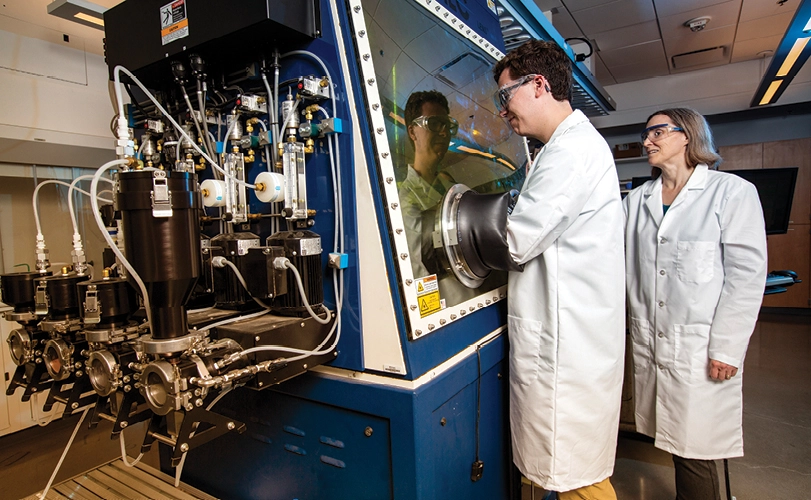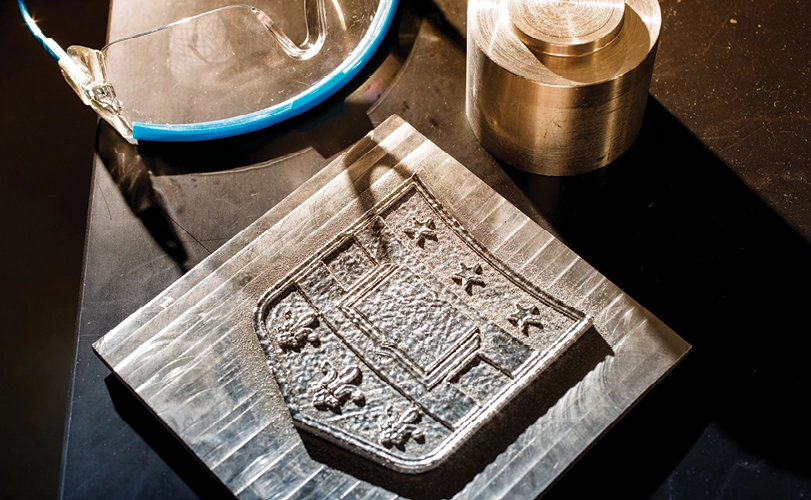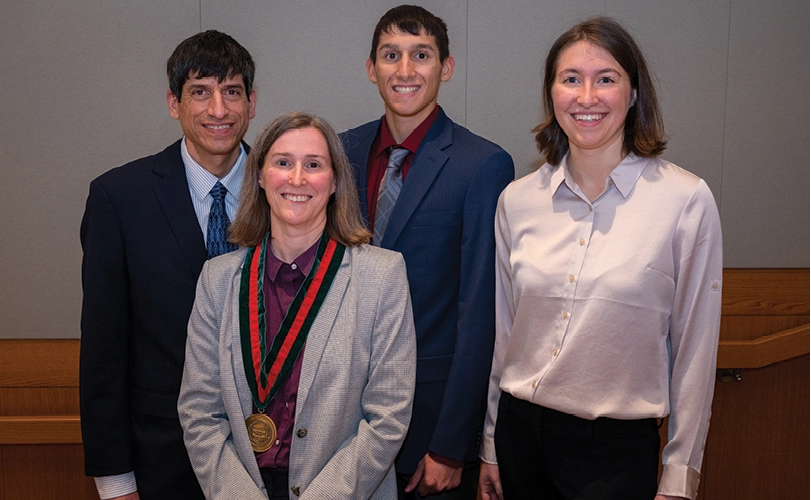The Right Stuff
Katharine Flores brings dedication, leadership and expertise to the McKelvey School of Engineering’s materials science program
Metallic glass. The concept sounds like a contradiction to most lay people, but for Katharine Flores, Christopher I. Byrnes Professor and director of the Institute of Materials Science & Engineering (IMSE) at Washington University in St. Louis, the unique material was the well-timed breakthrough that set her on her path as a leader and scholar.
Flores, who earned a bachelor’s degree in mechanical engineering from the School of Engineering in 1995, was first drawn to materials research during a co-op experience with McDonnell-Douglas Corp.
“I was fascinated by how you select a material for an application and how important that is to the final design,” Flores said. “You’re designing something from the atomic level up.”
She would go on to earn master’s and doctoral degrees in materials science and engineering from Stanford University. During this time, metallic glass would make its comeback in the materials space. Originally invented in the 1960s, metallic glass is a metallic material that has a disordered atomic structure. Most metals typically have a crystalline structure — that is, one that is highly organized.
It’s a competitive and interesting discipline with applications that span all of the other engineering disciplines and would draw students with an interest in fundamental and applied science.”
“The atoms will sit like eggs in an egg carton,” Flores said. “When we say ‘glass,’ everybody immediately thinks of window glass because silicates, which are what windows are made of, have an atomic structure that is very complex and difficult to organize in that orderly egg carton arrangement.”
Metallic glass underwent a renaissance in the ‘80s and ‘90s when researchers discovered new alloy materials that could be cooled more slowly while maintaining that disorganized structure. That allowed them to produce thicker and more practical products, such as sports equipment and electronics casings.
“We were able to make things that were millimeters or even centimeters in scale,” Flores said. “That’s something big enough to make structural things out of. I’m interested in the behavior of load-bearing materials, and my thesis was on understanding the fracture and fatigue behavior of these metallic glasses.”

Building a New Program
Flores’ first faculty position was with the Department of Materials Science and Engineering at The Ohio State University. She would remain there for 10 years before a fortuitous meeting with Kenneth Kelton, professor of physics in Arts & Sciences at WashU, who also researches metallic glass, at a professional conference.
“In his presentation, the WashU seal was on his opening slide,” Flores said. “I was surprised because I didn’t usually see materials people from WashU. It was a weird confluence of coincidences that WashU was starting to do something serious in the materials domain when I ran into Ken.”
They kept in touch for years before Kelton asked Flores to come to WashU to present a seminar and to provide guidance on the development of the university’s new materials science and engineering division.
“At that point in my career, I was thinking about what I wanted to do next,” Flores said. “Our meetings led to a conversation about the new unit, and I knew it would be a way of moving my career forward, giving back to WashU and bringing an area I was really excited about to a new level of prominence at the university.”
In 2012, Flores joined the School of Engineering as a professor of mechanical engineering & materials science and associate director of the new IMSE. Under her leadership, the institute launched its doctoral degree program in materials science and engineering in 2013, and since then, more than two dozen students have graduated from the program.

“The university wanted the institute to grow a doctoral program in a sustainable way,” Flores said. “I came in with the right level of visibility in materials science, brought an awareness of what a typical program would look like and what WashU needed to position itself to gain that level of recognition and visibility to our own.”
Flores briefly brought that same visibility to the Department of Energy, Environmental & Chemical Engineering when she served as interim department chair from November 2020 to May 2022.
“The motivation for that experience was to build the relationship between EECE and the materials sciences,” she said. “I got to appreciate environmental engineering and aerosols research and its connection to materials in a way I hadn't until that point.”
The Next Step
Flores has ambitions beyond the doctoral program for the institute, including attracting external funding to form a national research center.
“The Materials Research Science and Engineering Center program at the National Science Foundation has a call for proposals that comes around every three years, and I’ve pushed us to submit something every time,” she said. “I've also worked hard to bring together groups around other materials-focused opportunities. The IMSE holds regular seminars, workshops and brown-bag discussions to engage people throughout the university.”
Flores said she’d also like for the school to eventually offer an undergraduate degree in materials science and engineering. Currently, the school only offers a minor, which she helped develop, through the Department of Mechanical Engineering & Materials Science, of which she is associate chair.
“It’s a competitive and interesting discipline with applications that span all of the other engineering disciplines and would draw students with an interest in fundamental and applied science,” Flores said. “In my undergraduate classes, I tell them my goal is to get them to think about materials other than steel and concrete when they build something. If I can get people to go beyond stuff everyone’s already been making, then I call that a win.”


